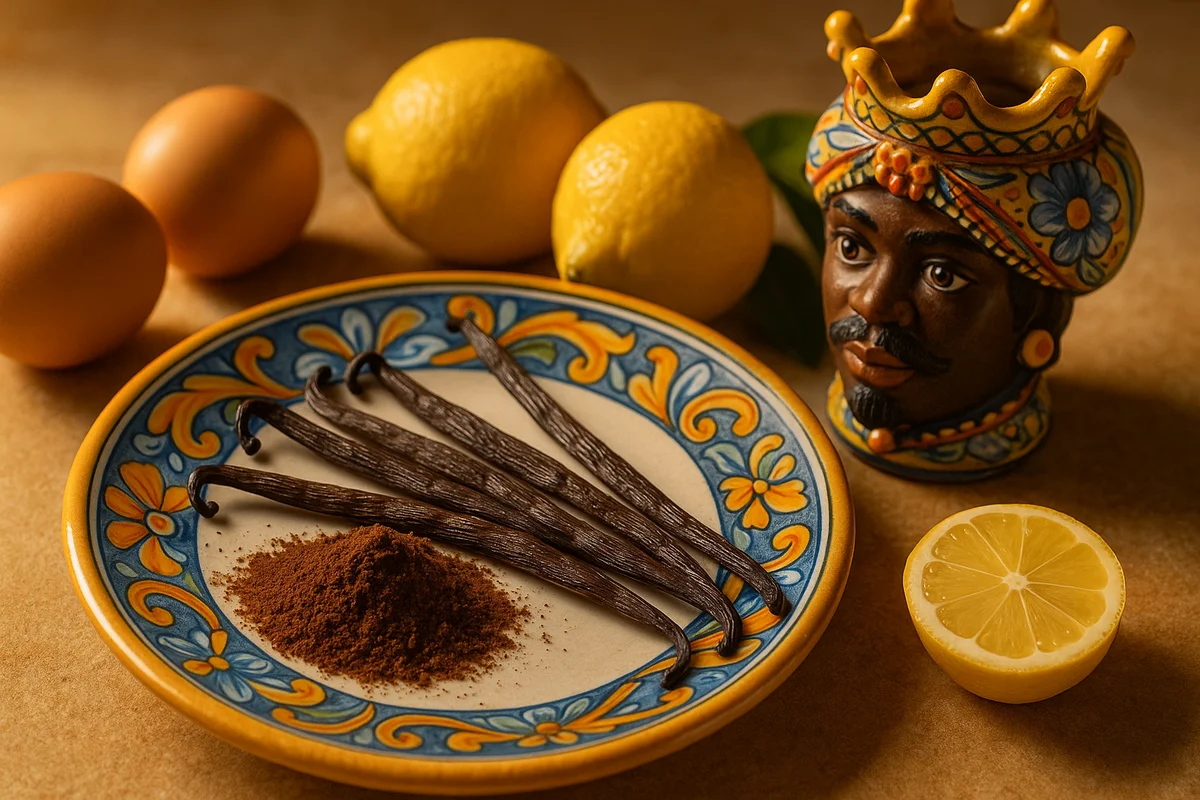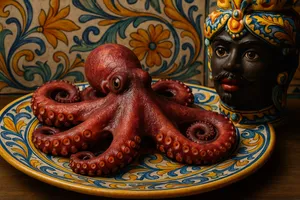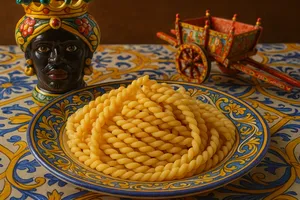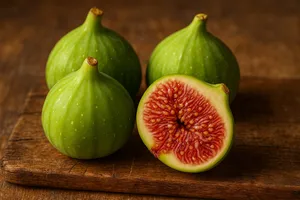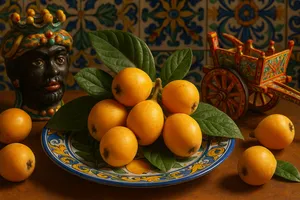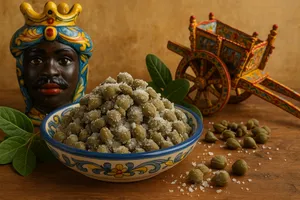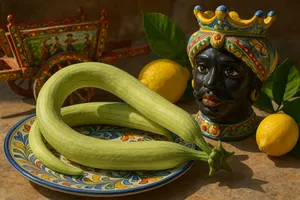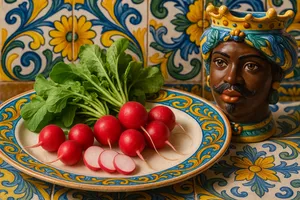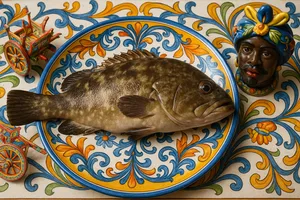Overview
Vanilla, known in Sicilian as “vanigghia”, is a prized spice obtained from the fermented and dried pods (technically “capsules” or “fruits”) of orchids belonging to the Vanilla genus, primarily Vanilla planifolia. It originates from Mexico and Central America, where the Aztecs used it to flavour cacao-based drinks. Today it is cultivated in tropical regions such as Madagascar, Tahiti, Mexico, Indonesia and Réunion. In Sicilian pastry, vanilla is a fundamental ingredient used to flavour creams (pastry cream, panna cotta), cakes, biscuits, gelato and traditional desserts such as cannoli and cassata. Its fragrance is sweet, warm and enveloping, with more than 250 aromatic compounds (the main one being vanillin). Real vanilla in pods is extremely expensive (second only to saffron) due to the labour-intensive cultivation and lengthy curing process. It symbolises sweetness, refinement and luxury.
Vanilla arrived in Europe following Spanish colonisation of the Americas. For centuries Mexico maintained a monopoly because the vanilla orchid required pollination by a specific bee (Melipona) found only there. In 1841, a 12-year-old enslaved boy named Edmond Albius in Réunion discovered a method for manual pollination, enabling cultivation worldwide. Vanilla is an ingredient that transforms simple preparations into fragrant delicacies — a luxury accessible to many (a single pod costs €3–10 but flavours numerous recipes), with a universally loved aroma that evokes comfort and childhood memories.
Characteristics
Vanilla pods are 10–20 cm long, thin (5–10 mm in diameter), dark brown to nearly black, with a slightly wrinkled, glossy, leathery surface. They are pliable, not brittle, and slightly moist. Inside they contain millions of tiny black seeds suspended in an oily, aromatic pulp (the “vanilla caviar”).
The fragrance is intense, sweet, warm and complex, with floral, caramel and spicy notes. The flavour is sweet with a subtle bitter undertone. High-quality pods are dark, flexible, oily to the touch and highly aromatic. They may display white crystals on the surface (vanillin crystallisation, a sign of quality). Dry, hard, broken or faintly aromatic pods are lower quality or old.
Types of vanilla
Bourbon Vanilla (Madagascar)
Mainly produced in Madagascar and the Indian Ocean islands (Réunion, Comoros, Mauritius). It represents 70–80% of global production. It has the classic rich, creamy, sweet aroma with caramel and custard notes. It is the standard vanilla for pastry: versatile and balanced.
Tahitian Vanilla (Tahiti)
A different species (Vanilla tahitensis), cultivated in French Polynesia. The pods are shorter, plumper and very dark. The aroma is floral, fruity, with notes of cherry and anise, exceptionally complex. It is used for refined preparations, gelato and creams. It is rarer and more expensive.
Mexican Vanilla
The original vanilla, cultivated in Mexico. It has a spicy, slightly smoky aroma with woody notes. It is rare and prized (just 2–3% of global production) and used by connoisseurs for special recipes.
Indonesian Vanilla
Produced in Indonesia (Papua, Java). It has a more delicate, slightly smoky aroma and is less complex. It is more affordable and often used in industrial production or when a milder aroma is desired.
Vanilla vs vanilla extract vs vanillin
Whole vanilla pods (natural): The highest-quality form, with a uniquely complex aroma. Both the seeds and pulp are used. It is expensive but irreplaceable in quality.
Natural vanilla extract: Pods macerated in alcohol to extract the aromatic compounds. Strongly flavoured and convenient, it is an acceptable and practical alternative. Ensure the label says “natural extract”, not “flavouring”.
Synthetic vanillin: A single molecule chemically produced (from lignin, guaiacol or petrochemical sources). It mimics vanilla but lacks complexity. Cheap and widely used in industry.
Vanilla flavouring: May be natural (extract-based) or synthetic (vanillin). The label reveals which: “natural vanilla flavour” vs “vanilla flavour”. The difference in quality is substantial.
Use in Sicilian pastry
Pastry cream
Vanilla is the classic flavouring for pastry cream used in cassata, cannoli, éclairs and cakes. Seeds and pulp from the pod (or extract) are infused into the milk, giving a distinctive fragrance.
Sicilian cannoli
The ricotta filling is often flavoured with vanilla. It enhances the sweetness of the ricotta and creates balance.
Cassata siciliana
Both the ricotta filling and the cream components are flavoured with vanilla, creating harmony throughout the dessert.
Gelato and sorbet
Vanilla gelato is a timeless classic. Real vanilla gives it a creamy colour (with visible seeds) and a strong, complex aroma.
Biscuits and pastries
Many Sicilian biscuits, almond pastries and sweets are flavoured with vanilla. A small amount elevates simple treats.
Cakes and spoon desserts
Vanilla is used in sponge cakes, simple cakes, panna cotta, puddings and creams — a universally loved aroma.
Vanilla sugar
Used or spent pods are added to sugar, which absorbs their fragrance. Vanilla sugar is used for baked goods, drinks and decoration.
How to use vanilla pods
To extract seeds and pulp:
1. Place the pod on a cutting board.
2. Using a sharp knife, cut it lengthwise.
3. Open the pod like a book.
4. Scrape out the seeds and pulp (“vanilla caviar”) with the back of the knife or a small spoon.
5. Add to your preparation (milk, cream, batter).
6. The emptied pod can still be used for infusions or to flavour sugar.
For infusions: immerse the whole pod (or pieces) in milk, cream or syrups and steep for 10–30 minutes. The pod releases its aroma gradually.
Storage
Store pods in a cool, dark place in an airtight container (glass jar, vacuum tube) to maintain moisture and aroma. They keep for 1–2 years if stored properly.
Do not refrigerate (risk of mould), and avoid heat or light (which degrade aroma). Pods should remain soft and pliable. If they dry out, rehydrate briefly in warm water or alcohol.
Vanilla extract keeps indefinitely if stored in a sealed dark bottle in a cool place—the alcohol preserves the aroma.
Buying tips
Buy high-quality vanilla from reputable suppliers. Check origin (Madagascar, Tahiti, Mexico), and grade (Grade A/Gourmet for pastry, Grade B for extracts).
Look for dark, flexible, oily, fragrant pods. Avoid dry, stiff, broken or weakly scented ones.
Price reflects quality: Bourbon Grade A typically costs €3–8 per pod, Tahitian €5–15. Suspiciously low prices indicate low quality.
For extracts: choose “natural vanilla extract” (not synthetic flavour). Labels should list real vanilla and alcohol. Organic and single-origin extracts offer superior quality.
Properties
Vanilla contains vanillin and over 250 aromatic compounds. It has mild antioxidant properties. Traditionally it was considered aphrodisiac, calming and digestive, though scientific evidence is limited.
Its aroma is proven to have soothing effects, reducing stress and anxiety. Widely used in aromatherapy, its sweet scent evokes comfort and pleasant memories.
Vanilla is generally safe for consumption, with allergies being rare.
History and curiosities
Vanilla originates from Mexico, where the Totonac and Aztec peoples used it to flavour cacao drinks. The Aztecs called it “tlilxochitl” (black flower).
Hernán Cortés introduced vanilla to Europe in the 16th century, where it became a luxury spice among royal courts. For centuries only Mexico produced it, due to its dependence on a specific pollinator.
In 1841, Edmond Albius, a 12-year-old enslaved boy in Réunion, discovered manual pollination, revolutionising the global vanilla industry — an extraordinary story of ingenuity.
Vanilla is the world’s second most expensive spice after saffron because the orchid takes three years to flower, each blossom must be hand-pollinated within a few hours, the pods need nine months to mature, and curing takes 2–6 months. It is an exceptionally labour-intensive process.
Vanilla prices are volatile: in 2017–2018 they reached $600/kg due to poor harvests in Madagascar and rising demand, surpassing the price of silver.
An old saying calls vanilla the “queen of spices”, highlighting its regal fragrance, high price and use in luxurious preparations.
Synthetic vanillin was first produced in 1874. Today 99% of commercial vanillin is synthetic. Natural vanilla contains over 250 compounds, while synthetic vanillin contains just one — the difference is profound.
In perfumery and aromatherapy, vanilla is valued for its versatility: it blends harmoniously with floral, fruity, spicy and woody notes, often serving as a warm base note.
Madagascar produces 70–80% of the world’s vanilla. A cyclone or poor harvest can trigger a global price crisis, illustrating the fragility of highly concentrated supply chains.

